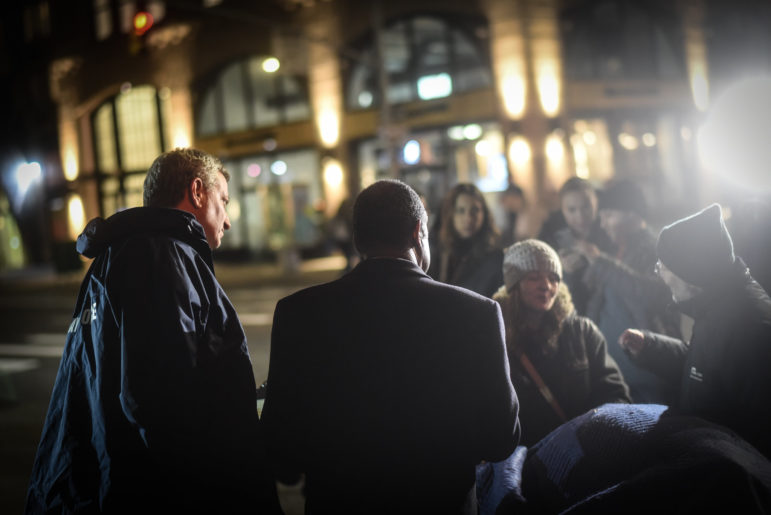The city’s annual count of street homeless New Yorkers recorded a 38 percent decrease. But advocates say the city increased enforcement against homeless encampments—known as sweeps or clean-ups—in the days leading up to the 2021 census.

Michael Appleton/Mayoral Photography Office
Mayor de Blasio participating in the 2021 HOPE survey in January.Mayor Bill de Blasio touted a significant decrease in the number of people identified in its annual street homeless count—but advocates caution that a spike in enforcement, and a new census methodology, likely obscure the true extent of the crisis.
The city’s annual Homeless Outreach Population Estimate (HOPE) count identified 2,376 different New Yorkers bedding down in public places between Jan. 26th and 29th, compared to 3,857 on Jan. 27, 2020, according to results released Thursday. The number marks a 38 percent decrease, including a 23 percent drop in the subway system.
De Blasio on Thursday hailed the decline as a testament to city policies designed to move people off the subways and sidewalks and into shelters, including 1,300 new sites specifically intended for street homeless New Yorkers. The sites, known as stabilization or Safe Haven beds, provide private spaces, often in commercial hotels, without the typical barriers and curfews imposed at other shelters.
“Some things were absolutely proven,” de Blasio said at a press briefing. “The specialized beds that encouraged people to come in worked. We know that they worked.”
He also praised nonprofit outreach workers who forge relationships with people staying in public spaces and encourage them to move into temporary shelters. “We know that more outreach staff helps because we’ve seen the miraculous work,” he said. “They are amazing human beings.”
Advocates acknowledge the impact of the specialized beds and the work of outreach teams, but say the city’s narrative about this most recent HOPE Count paints an incomplete picture.
“It’s already apples and oranges every year, but because of the increased criminalization and displacement of people on the subways and moving people around all the time, it’s not surprising that the city wouldn’t count as many people,” said Coalition for the Homeless Policy Director Giselle Routhier. “But it’s because of their own inhumane policies, not because of an actual reduction in homelessness.”
Routhier specifically cited an uptick in enforcement, known as sweeps or clean-ups, against people staying in public spaces ahead of the count. After providing a few days’ notice, city Sanitation workers conducting the sweeps clear bedding and belongings from public spaces while a Department of Homeless Services (DHS) official encourages the person to move into a temporary shelter.
Ahead of the HOPE Count, the city stepped up these number of sweeps, according to records obtained by the Safety Net Project, a group that is part of the Urban Justice Center. A DHS spokesperson said city officials “address conditions as they occur.”
There were 16 sweeps on Jan. 19, a week before the start of the count, followed by 14 on Jan. 22 and again on Jan. 23. On Jan. 26, the first day of the count, city officials performed 20 sweeps, according to records. In contrast, the city conducted about 3.7 sweeps per day in 2020, more than double the number in 2019.
There were 316 sweeps in January — just over 10 a day — compared to 191 in December 2020, the data shows.
Routhier and other advocates pointed to a few other factors that also likely contributed to this year’s lower tally, including the count methodology and the suspension of overnight subway service sending street homeless New Yorkers into harder-to-find places.
The COVID-19 pandemic compelled the city to take a different approach to what is usually a one-day census that relies on thousands of volunteers to talk with and identify people sleeping on sidewalks, subway platforms and parks. The volunteers usually go out between 12:15 and 4 a.m. The city instead assigned professional outreach workers to canvass over four nights in January, from 10 p.m. to 1 a.m.
Nevertheless, advocates say, the increased number of stabilization beds have indeed had an impact and enabled more people to move off the street.
A majority of people staying in public spaces say they first tried the city shelter system before finding it was too unsafe or inadequate to meet their needs, according to an April survey by the Coalition for the Homeless. The private or semi-private stabilization beds provide an alternative and should become permanent even as the COVID-19 pandemic subsides, advocates say — though their ultimate goal remains permanent housing for all homeless New Yorkers.
In its most recent annual “State of the Homeless” report, the Coalition for the Homeless urged the city to establish 3,000 stabilization and Safe Haven beds, enough for every person staying in the streets and subways. They also urged the city to provide transportation to the sites for everyone offered placement.
Homeless Services United (HSU) Executive Director Catherine Trapani, whose organization represents homeless service providers, praised the stabilization bed model.
“We know stabilization beds and low-barrier access to housing works and we’re proud of the work our members do to get people off the street,” Trapani said.
HSU members include Bowery Residents’ Committee (BRC), the nonprofit agency that contracts with the city to perform homeless outreach.
In a statement, BRC President Muzzy Rosenblatt said their outreach efforts mean “hundreds of New Yorkers who a year ago were sleeping on the subways are now sleeping safely in beds.”
Most advocates and lawmakers focused on homelessness put little stock in the flawed HOPE Count, however.
“The HOPE Count is a data point, but it’s hard to ascribe too much significance to it,” said Councilmember Stephen Levin, chair of the City Council’s general welfare committee. “I think it’s possible it speaks to an effectiveness in the increase of stabilization and Safe Haven beds … but it’s such an unusual year and with the different methodology, I wouldn’t say it’s a clear indication of anything.”









